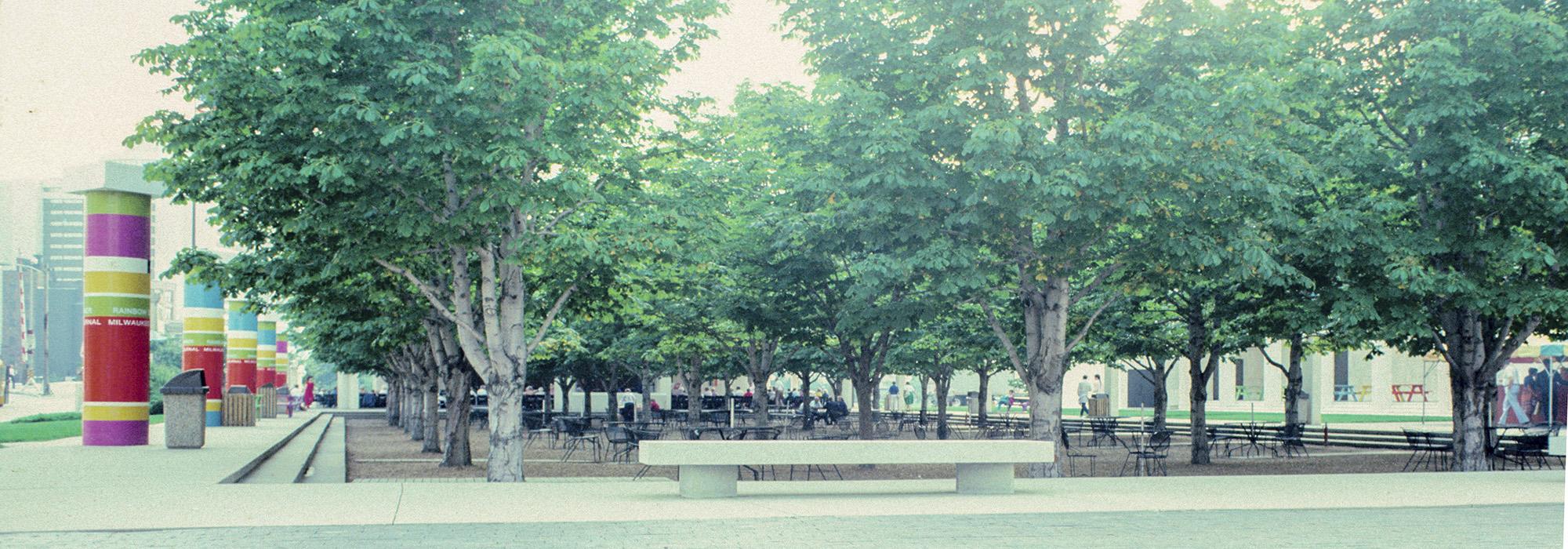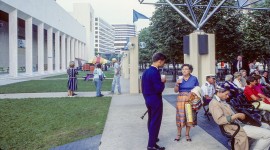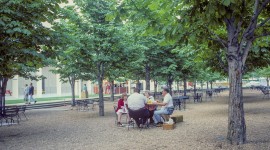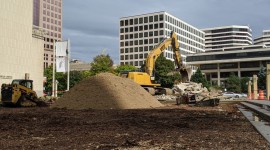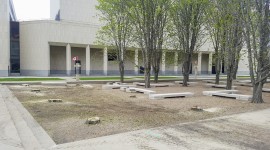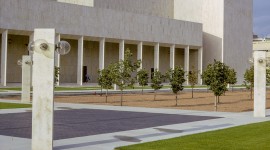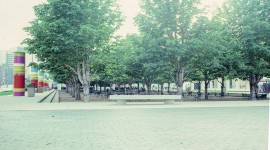Demolition of Kiley’s Chestnut Grove Delayed
The Marcus Center for the Performing Arts in Milwaukee, Wisconsin, has been granted temporary historic status by the Milwaukee Historic Preservation Commission (HPC), thereby effectively halting any redevelopment of the grounds. The 3.65-acre complex was designed in the mid-1960s by Chicago architect Harry Weese, and the landscape was designed by the celebrated postwar landscape architect Dan Kiley (recipient of the Presidential Medal for Arts in 1997). The recent designation, which will remain in place for a maximum of 180 days, was granted because the building and adjoining landscape were identified as an exemplary example of postwar architecture, fulfilling at least four of the ten criteria the city requires for historic designation— including “its exemplification and development of the cultural, economic, social or historic heritage of the city.”
Landscape architect Jennifer Current and architect Mark Debrauske nominated the site for historic designation in January 2019, having been inspired by an exhibition on Dan Kiley at UW-Milwaukee produced by The Cultural Landscape Foundation (read Jennifer Current's public statement to the City of Milwaukee Preservation Commission here). Meanwhile, despite the historic designation, the Marcus Center has asked the HPC to authorize the removal of four horse chestnut trees from Kiley’s iconic grove, claiming that the trees are damaged and represent a public hazard. However, the assessment report commissioned by the Marcus Center admits that the overall risk factor is low and recommends an annual inspection of the landscape to track further deterioration.
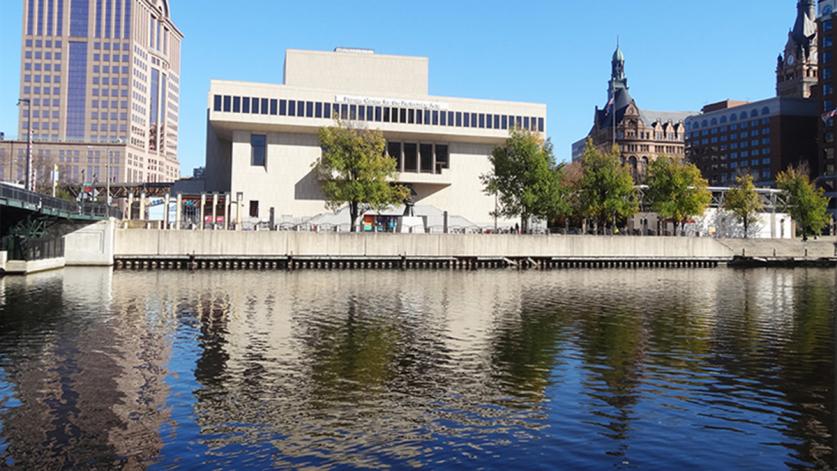
On December 7, 2018, the Marcus Center for the Performing Arts announced its vision for a reimagined campus plan, which sought to create a more open and flexible outdoor space to host events and help generate revenue. The center also cited shrinking public-sector funding as a reason for its decision. The proposed redesign, developed by HGA, CG Schmidt, Inc., and Schuler Shook Theater Consultants, envisioned a new landscape around the Peck Pavilion, which would entail expanding the plaza and replacing Kiley’s grove of horse chestnut trees with a lawn lined by nine trees on either side. These changes to the landscape would be accompanied by alterations to Weese’s building, adding more windows to its Brutalist façade. Construction was scheduled to begin this spring, with the redesign implemented in multiple phases over the next three to five years.
“It’s a generic approach. It’s a program-driven, tabula rasa approach that does not put a value or a depth of understanding on what is there now.” — Charles A. Birnbaum, FASLA
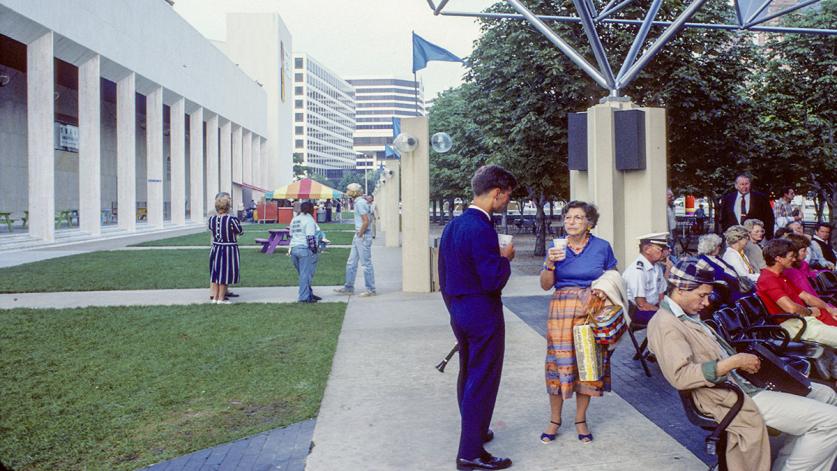
In a radio interview on February 14, 2019, Mary Louise Schumacher, the art and architecture critic for the Milwaukee Journal Sentinel from 2001 to 2019, told WUMW Milwaukee: “I honestly do not remember getting so much reaction from readers in years…99.9% of it was in favor of keeping that grove in Milwaukee… [The grove] has not been programmed well for years, and I think that has had an impact on it overall.” Schumacher also said that the Marcus Center’s redevelopment strategy of “marketing by architecture” to draw new, young audiences to its programs might not necessarily be successful, and it might be the programs themselves that need reinvention.
The grove was a popular and vibrant gathering space during the Rainbow Summer (a free outdoor concert series that took place during lunch hours at the Peck Pavilion) and the setting of the “Poets in the Grove” series in the 1980s that featured novelists of the caliber of Margaret Atwood. The landscape has historically provided a chapel-like atmosphere for both intellectual contemplation and public gatherings. But the grove has not been maintained: most of the 36 trees are wildly shaped, and sunlight can no longer penetrate the thick, overgrown, foliage in summer. The gravel used to pave the grove is not ADA-accessible, but according to Joe Karr, FASLA, who worked with Kiley from 1963 to 1969, the current layout of the Marcus Center has enough space to easily accommodate a ramp, upgrading the landscape in keeping with ADA norms. HGA’s James Shields, the architect behind the new plan, believes that the grove could be replanted in a week—an assessment that, perhaps unintentionally, bolsters the argument for its revitalization.
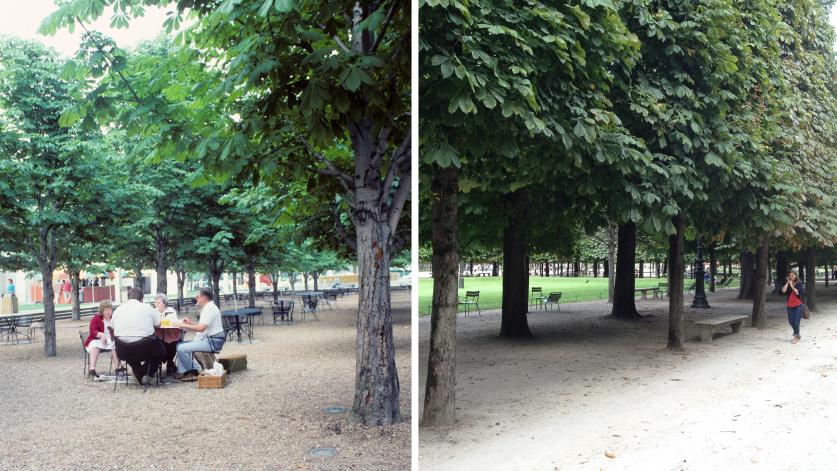
The construction of the Milwaukee Performing Art Center began in 1966, in tandem with the design of the surrounding grounds. Kiley’s architectonic sense and Weese’s keen interest in the landscape created a seamless dialogue between the landscape and the architecture. Kiley’s design consisted of a grid of grass rectangles bounded by pavement surrounding the central trapezoidal plaza. The sunken central space can be reached by descending three steps from the adjacent pathways. The court’s ground is covered with crushed stone and features 36 horse chestnut trees laid out in a 4 x 9 grid. The spacing of the trees varies from eighteen feet apart on the eastern end of the plaza to just over 21 feet on the western end, thereby adroitly masking the slightly trapezoidal shape of the plaza and giving the illusion of a perfect rectangle. The grove also speaks directly to Kiley’s time in Europe, specifically the influence that the Jardin des Tuileries in Paris, France, had upon his later works. In this respect, the Marcus Center’s plaza demonstrates to great advantage “the spatial and compositional power of the simplest elements…”
TCLF enrolled the Marcus Center for Performing Arts in its Landslide program in December 2018 after it was alerted to the imminent destruction of the grove. Because the County of Milwaukee leases this public space to the Marcus Center, TCLF maintains that there should be public consensus before it is destroyed.



